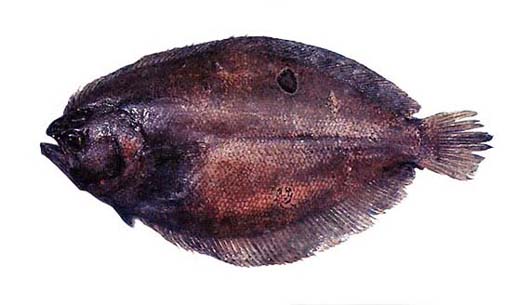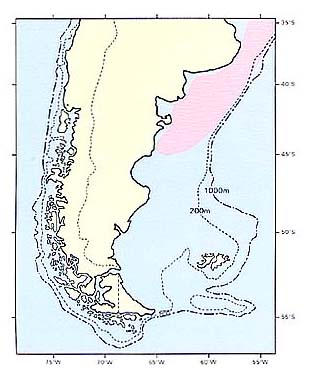ダルマガレイ科
- HOME
- デジタル図鑑
- パタゴニア海域の重要水族
- 硬骨魚綱 カレイ目
- ダルマガレイ科
ダルマガレイ科(Bothidae)

121 ブラジルヒラメ(Burajiru-hirame)
Paralichthys isoscelesJordan, 1890
Lenguado(Arg.)
特 徴:
背鰭82軟条,臀鰭65軟条,胸鰭10軟条,腹鰭1棘,5軟条,鰓耙数1+10=11,鰓条骨数7,側線鱗線78。体長に対する頭長の割合は28.5%,眼径は2.7%,骨質眼窩径は5.2%,体高は49.8%,吻長は5.7%,両眼間隔(肉質)は1.4%,両眼間隔(骨質)は5.7%,上顎長は14.3%,尾柄高は11.1%,胸鰭長は16.5%,腹鰭長は7.5%,背鰭高は11.3%,臀鰭高は11.2%。体は楕円形で,体高は頭長の2倍より低い。頭部背縁は上眼の前方でややくぼむ。吻は前方に突出し,吻長は眼径より大きい。上眼は下眼よりやや前方に位置する。両眼間隔域は眼径より狭く,骨質の隆起縁がある。両顎はかなり湾曲し,上顎後端は眼の後縁をはるかに越える。上顎は下顎よりやや前方に突出する。両顎歯は小さな犬歯状歯で前方に少し湾曲し,1列にならぶ。鱗は薄くて,弱い小櫛鱗。両顎および眼隔域は被鱗しない。前鼻孔は鼻弁を有する。背鱗は上眼の前方に発する。臀鰭は鰓蓋骨後縁下に始まる。胸鰭は幅狭く,細長く,上顎より長い。有眼側の腹鰭は前鰓蓋骨後縁下に始まる。無眼側の腹鰭は有眼側の腹鰭よりやや前方に位置する。側線は1本で,胸鰭上方で大きく湾曲しつつ,以後体側中央を直走する。鰓蓋部上方に前方に向う分枝を出す。有眼側は一様に褐色,体側中央付近に側線をはさんで対称的な位置に大きな1対の黒斑を有す。尾柄部のやや前方の側線上に小さな1黒斑がある。無眼側は乳白色。体長30cmを越えると考えられるがParalichthys brasiliensisよりは小さい。
分 布:
アルゼンチン パタゴニア北部の陸棚上に分布する。
備 考:
肉質は白身で良好。本種はブラジル分布するP. triocellatus Ribeiro, 1904と同種かも知れないが,なお研究を要する(Norman, 1934)。
(中村 泉)
Material examined:
1 from Argentina (302.5 mm SL), FAKU AP 823.
Description:
D 82; A 65; P1L 10; P2 Ⅰ, 5; GR 1+10=11; BR 7; LLS 78. HL 28.5% of SL; ED 2.7; BO 5.2; BD 49.8; SN 5.7; FO 1.4; BO 5.7; UJ 14.3; CP 11.1; P1L 16.5; P2L 7.5; DH 11.3; AH 11.2.
Body elliptical and extremely depressed, body depth about 2 times in SL. Head large, about 3.6 times in SL. Snout short, about equal to fleshy orbit. Upper profile of head anterior to upper eye slightly concave. Eye large, lower eye slightly anterior to upper eye, fleshy orbit 4.5 times in head. Mouth curved and oblique, posterior margin of upper jaw reaching lower eye. Upper jaw slightly anterior to lower jaw. Sharp fine conical teeth uniserial on both jaws, teeth on lower jaw larger and more sparsely arranged than teeth on upper jaw. No teeth on vomer or palatines. Gill-rakers short and stout with fine inner serrations. Pseudobranchiae present. Nostrils on ocular side situated close each other, anterior to eye, naerer to eye than to tip of snout, anterior nostril round with a flap and posterior nostril round without a flap and larger than anterior nostril. Nostrils on blind side situated closely each other and near to dorsal profile of head, similar to nostrils on ocular side. Interorbital region very narrow with a bony ridge. Dorsal fin originating from blind side, just above posterior nostril. Pectoral fin long, slender, its length about 1.7 times in head on ocular side and 2.5 on blind side. Pelvic fins slightly longer on blind side than on ocular side. Caudal fin double truncate. Scales on both blind and ocular sides ctenoid. Lateral line with a branch and a curving anteriorly and fairly straight posteriorly.
Distribution:
Coasts of Brazil to Argentina.
Remarks:
This species may prove to be identical with P. triocellatus Ribeiro, 1904 over which P. isoseles has priority (Norman, 1934).
(Izumi NAKAMURA)

Distribution of Paralichthys isosceles in Patagonia.

Head. Dorsal fin origin arrowed.